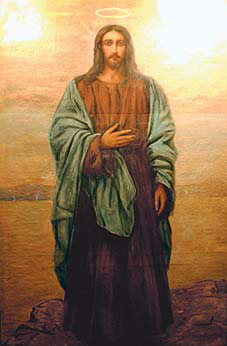|
Glowing
painting in New Mexico church
For
decades tens of thousands of people annually have visited a painting hanging
in the San Francisco de Asis Mission in Rancho de Taos, New
Mexico. The Shadow of the Cross, painted in 1896 by little-known French-
Canadian artist Henri Ault, appears to glow in the dark for no apparent
reason.
|
When lights in the room are turned off, the life-sized image of
Jesus standing on the shore of the Sea of Galilee fades to a shadow
as the white clouds in pale blue sky and green water begin to glow
around him, as if all were bathed in moonlight.
Soon the silhouette of Jesus grows threedimensional and appears
more like a dark statue than flat image. His robes seem to billow
in a breeze. Over his left shoulder the shadow of a cross is distinct
to most visitors. Some can see a halo over his head and the bow
of a small fishing boat on the shore.
The Catholic Church does not call the 8-foot painting of Jesus miraculous
or make any claim about it other than to say it is a phenomenon
not perfectly understood. Many assume the painting's effects, which
last indefinitely in darkness, result from the painter's skilful
technique.
Ault, however, denied that he was responsible for the painting's
surreal features. He never duplicated the effects in other works,
which were mostly landscapes. "It is said that he was very
surprised when he walked into his studio one night and saw the painting
glowing in the dark," archivist Corina Santistevan says.
The Shadow of the Cross was the sensation of the 1904 World's Fair
in St Louis, Missouri, USA. It was exhibited at the Dore Galleries
of London and also shown in other European cities. In 1948, a wealthy
Texan, Mrs Herbert Sidney Griffin, bought the painting and donated
it to the church in her second, chosen hometown of Rancho de Taos.
|
 |
| "The
Shadow of the Cross" |
|
Although
parish records are incomplete, Santistevan says that scientists from the
national laboratory at nearby Los Alamos, New Mexico, tested the
painting for radioactivity and perhaps even for the presence of some phosphorescent
minerals. The Geiger counter results were negative, and other tests were
inconclusive. "We know the painting is a mystery but not a miracle,"
Santistevan says. "As far as I know the painting has not been
responsible for any healing. Grant you, it is very moving. People have
an emotional response to it, and that is something the church neither
approves
or disapproves of."
(Source: Denver Post, USA)
Editorial note
Editorial note:
Benjamin
Creme's Master confirms that this miracle was manifested by the Master
Jesus.
According to Benjamin Creme, editor of Share
International magazine, all the miracles are signs of the imminent
emergence of Maitreya, the World Teacher, and his group, the Masters of
Wisdom. They are the custodians of the Divine Plan for this planet and
are returning now to show us the way out of our current difficulties and
bring the new teachings which will guide humanity towards its next evolutionary
step. Soon we will see Maitreya on television, interviewed on a major
American network and hear his call for sharing and justice, as the only
way to peace.
Benjamin Creme writes: "Over many years Maitreya and his group of Masters
have saturated the world with miracles. All religious groups look for
signs. It is through the signs that they know the teacher is in the world
or is coming into the world. You only have to keep awake and you will
see that signs are everywhere. In every country in the world, in every
religious setting, there are signs of one kind or another."
His telepathic contact with a Master of Wisdom allows Benjamin Creme to
receive up-to-date information on the Maitreya's emergence and to expand
on the Ageless Wisdom Teachings. Through this contact Benjamin Creme's
Master regularly confirms whether a phenomenon is a miracle that was manifested
by one or other of the Masters. Most the miracles are manifested by Maitreya
Himself, the Master Jesus or the Master Who was the Madonna.
from: Share International April 2003
Reprinted by courtesy of © Share
International
|
